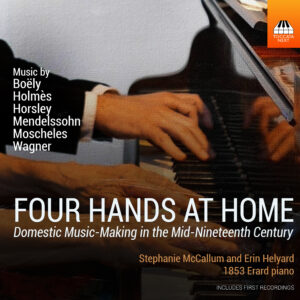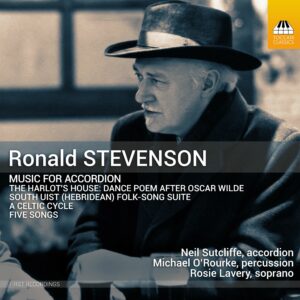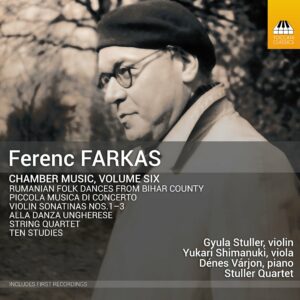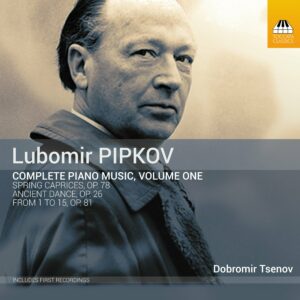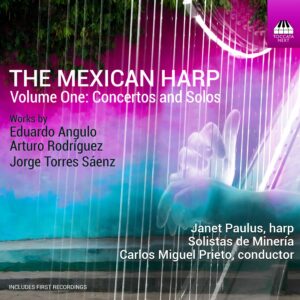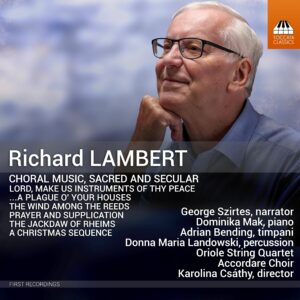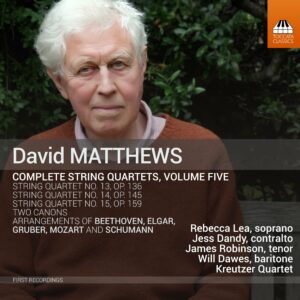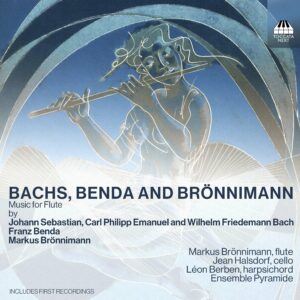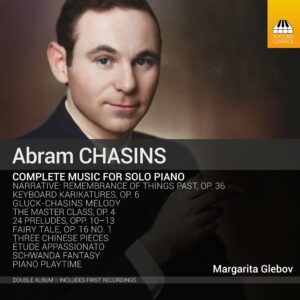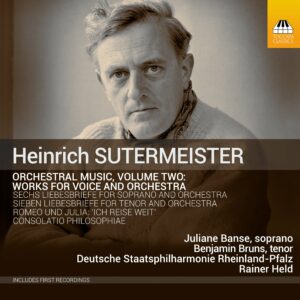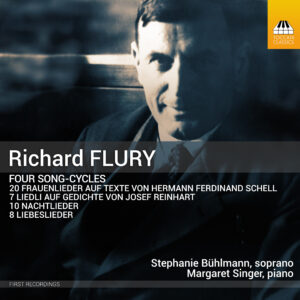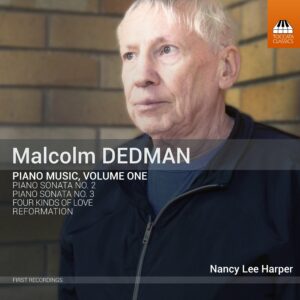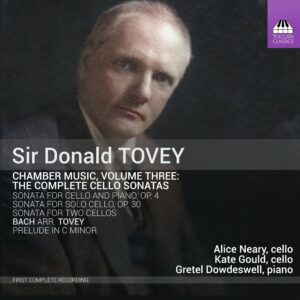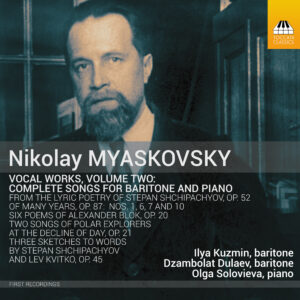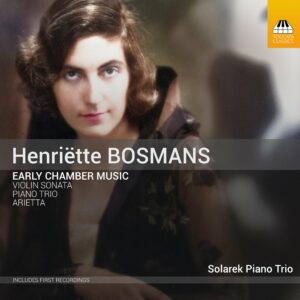Search Results for "Space Wolf: The First Omnibus mp3 torrent" – Page 2
Four Hands at Home: Domestic Music-Making in the Mid-Nineteenth Century
Playing piano four-hands was both vital in the dissemination of music in the nineteenth century and also a popular domestic activity. The original 1853 Parisian Erard piano on which this recording was made demonstrates the clarity, warmth and differentiated timbres characteristic of the ‘straight stringing’ that was later replaced by the ‘cross-stringing’ of the modern concert grand. The repertoire from the period covers the many genres of four-hand piano works in their varied roles as domestic ‘info-entertainment’: orchestral works large and small, serious sonatas and variations, showpieces for emerging virtuosi and even a string quartet are all equally engaging in this once-familiar medium.
Stephanie McCallum (primo) and Erin Helyard (secondo), 1853 Érard Piano
Ronald Stevenson: Music for Accordion
Ronald Stevenson (1928–2015) is best remembered for his huge output of music for the piano, an instrument he played with a rare understanding of tonal colour. It was thus entirely within character that he responded enthusiastically to the opportunity to explore the musical possibilities of the accordion, most impressively in a ‘Dance Poem’ of some scale. Stevenson was also an inveterate transcriber, producing hundreds of piano versions of pieces written for other forces. Neil Sutcliffe here returns the compliment, transcribing one of Stevenson’s own piano works and five of his songs for accordion, pulling the classical world and Scottish traditional music a little closer together.
Neil Sutcliffe, accordion
Michae O’Rourke, percussion
Rosie Lavery, soprano
Ferenc Farkas: Chamber Music, Volume Six
This thirteenth release in the Toccata Classics exploration of the music of Ferenc Farkas (1905–2000) puts some of his chamber music with violin in the spotlight – bookended here by two works for string quartet. As with previous albums in this series, the music highlights the characteristics that make Farkas’ music so appealing: catchy tunes, transparent textures, buoyant rhythms, a fondness for Baroque forms and a taste for the folk-music of his native Hungary that marks him out as a true successor to Bartók and Kodály.
Gyula Stuller, violin (5–25)
Yukari Shimanuki, viola (5–14)
Dénes Várjon, piano (15–25)
Stuller Quartet (1–4, 26–28)
Gyula Stuller, Barnabás Stuller, violins
Yukari Shimanuki, viola
Júlia Stuller, cello
Lubomir Pipkov: Complete Piano Music, Volume One
Lubomir Pipkov (1904–74) was one of the leading members of the so-called ‘second generation’ of Bulgarian composers. In later life he became fascinated with the ancient heritage of Bulgarian folk-music, writing a series of what he called ‘metro-rhythmical studies’ – piano miniatures that combine melodic immediacy and rhythmic complexity, with a character that might be loosely characterised as sounding like ‘Prokofiev in the Balkans’.
Dobromir Tsenov, piano
The Mexican Harp Volume One: Concertos and Solos
With this first Toccata Next album of Mexican music for harp, the American harpist Janet Paulus pays tribute to her adoptive country and to three composer friends, each with a concertante work and music for solo harp – several of them recently written for her. The predominant style is gently Neo-Romantic, occasionally animated with echoes of Mexican folk-music.
Janet Paulus, harp
Solistas de Minería (Tracks 2–5, 10-12)
Carlos Miguel Prieto, conductor (Tracks 2-5, 10-12)
Richard Lambert: Choral Music, Sacred and Secular
The choral music of Richard Lambert, born in Bath in the English West Country in 1951, covers a wide range of expression, ranging on this album from straightforward SATB settings for church performance to a sardonic parody of the excesses of established religion. It also encompasses the timeless and the timely, with a number of contributions to the age-old tradition of Christmas music to a cantata inspired by the Covid pandemic.
This is the first recording of the Accordare Choir, founded and conducted by Karolina Csáthy, initially using former choral scholars of The Choir of Trinity College Cambridge; since then it has expanded in size, scope and accomplishment.
George Szirtes, narrator
Dominika Mak, piano
Adrian Bending, timpani
Donna Maria Landowski, percussion
Accordare Choir
Karolina Csáthy, director
David Matthews: Complete String Quartets, Volume Five
The American critic Robert Reilly described the music on Volume One of this cycle of the complete string quartets of David Matthews (b. 1943) as ‘some of the most concentrated, penetrating writing for this medium in the past 30 years or more. It is musical thinking of the highest order and quartet writing in the great tradition of Beethoven, Bartók, Britten, and Tippett’. Matthews’ three most recent quartets call in a wide range of references. Birdsong – heard in Nos. 13 and 14 – is a standard Matthews topos; and the fugal No. 15 seems to find a middle ground between late Beethoven and folk-music. No. 13 presents the biggest surprise: it introduces four solo voices, siting the work somewhere between Berg’s Lyric Suite and Vaughan Williams’ Serenade to Music. Some touching arrangements and two canons for two Michaels – Tippett and Berkeley – complete the programme.
Rebecca Lea, soprano 8
Jess Dandy, contralto 8
James Robinson, tenor 8
Will Dawes, baritone 8
Kreutzer Quartet
Peter Sheppard Skærved and Mihailo Trandafilovski, violins
Clifton Harrison, viola
Neil Heyde, cello
Livia Teodorescu-Ciocănea: Orchestral Music
These three works by the Romanian composer Livia Teodorescu-Ciocănea (b. 1959) show her approach to three of the central genres of the western classical tradition: symphony, concerto and cantata. The powerful and programmatic Archimedes Symphony was inspired by the death of Archimedes in the siege of Syracuse in 214 BC; the Rite for Enchanting the Air – a concerto for various flutes and orchestra – is a kind of magical journey into a dizzying world of sound and colour; and the cantata Mysterium tremendum aims to reconcile Byzantine and Catholic liturgical traditions. All three make clear her fascination with orchestral timbre and texture – and have distant roots in Romanian folk-music.
Pierre-Yves Artaud, flutes (Tracks 5–8
Antonela Barnat, mezzo-soprano (Tracks 9–12)
Romanian Radio National Orchestra (Tracks 1–8)
Radio Romania Chamber Orchestra (Tracks 9–12)
Valentin Doni (Tracks 1–4)
Alan Tongue (Tracks 5–8)
Cristian Oroșanu (Tracks 9–12), conductors
Bachs, Benda and Brönnimann
Four of the composers on this recording met in real life – in Potsdam, in spring 1747. In this album they are reunited, joined by the flautist-composer who brings their encounter to life once more, the Swiss-born Markus Brönnimann. The stylistic contrasts between works three centuries apart serve to accentuate their strengths, the formal elegance of the earlier pieces underlining the expressive liberty of the recent ones. Brönnimann combines the two worlds with his luminous arrangement of one of the best-known of all classical compositions.
Markus Brönnimann, flute
Jean Halsdorf, cello (Tracks 1–3, 7–9, 11–13, 15–18)
Léon Berben, harpsichord (Tracks 1–3, 7–9, 11–13, 15–18)
Ensemble Pyramide (Tracks 4–6, 10)
Markus Brönnimann, flute Barbara Tillmann, oboe
Ulrike Jacoby, violin
Muriel Schweizer, viola
Anita Jehli, cello
Marie Trottmann, harp
Abram Chasins: Complete Music for Piano Solo
Abram Chasins (1903–87) began his career as a pianist and composer but as broadcaster and writer soon became one of the best-known cultural commentators in the USA. His output of music for solo piano – recorded here complete for the first time – dates from his first years in the public eye, and although he made little attempt to promote it himself, one sees instantly why it was so well received at the time: sweeping keyboard textures and grand Romantic gestures expressed in a style somewhere between Rachmaninov and Prokofiev, sometimes with echoes of Chopin and Gershwin. The works here range from witty character pieces, some intended for children, and affectionate tributes to other pianists to more serious abstract essays – and Chasins, too, was a member of the club of composers who wrote 24 preludes in all the major and minor keys.
Margarita Glebov, piano
Heinrich Sutermeister: Orchestral Works, Volume Two
Heinrich Sutermeister (1910–95) belongs to the generation of Swiss composers after Bloch, Honegger, Martin and Schoeck. His operatic version of Romeo and Juliet soon spread his reputation far afield, and conductors as prominent as Böhm, Karajan and Sawallisch championed his works, although since his death his music has not had the attention it deserves. These four big-boned works – a powerful setting of Boethius, an extract from Romeo und Julia and two sets of moving love-letters from genuine historical figures in Renaissance, Baroque and Enlightenment Germany and Switzerland – attest to the acuity of his ear in balancing voice and large orchestra and confirm his instinct for drama.
Juliane Banse, soprano (1–9, 17–22)
Benjamin Bruns, tenor (10–16)
Deutsche Staatsphilharmonie Rheinland-Pfalz
Rainer Held, conductor
Richard Flury: Four Song-Cycles
The output of Richard Flury (1896-1967), one of Switzerland’s most prolific composers, ranges from operas and ballets to symphonies, instrumental concertos, sacred and secular vocal works, chamber music and no fewer than 181 songs with piano accompaniment. These four song-cycles, written between 1920 and 1946, contain 45 of them, their concision nonetheless embracing an expansive, Romantic style of which Schumann himself might have approved. The prevailing mood is one of an open-hearted sincerity, occasionally enlivened by a dash of humour.
Stephanie Bühlmann, soprano
Margaret Singer, piano
Malcolm Dedman: Piano Music, Volume One
A number of diverse influences have helped shape the musical language of Malcolm Dedman (born in London in 1948 but resident in provincial South Africa since 2007), among them Bartók and Messiaen, his Bahá’í Faith and, more recently, his new South African homeland. Points of contact with other composers can be heard, too, not least Debussy, Ravel, Barber and Ginastera. These piano works embody a wide range of moods, from gentle introspection to energetic, dissonant vigour.
Nancy Lee Harper, piano
Sir Donald Tovey: Chamber Music, Volume Three: The Complete Cello Sonatas
Sir Donald Tovey (1875–1940), long hailed as one of the finest writers on music in English, saw himself primarily as a composer. His occasionally turbulent friendship with Pau Casals was the spur for a monumental concerto and one of his three cello sonatas: for solo cello, two cellos and cello with piano. The cello was the ideal instrument for Tovey’s Brahmsian musical language, with its long, singing lines unfolding in effortless counterpoint – though the huge passacaglia that ends the solo sonata also demands a virtuoso technique. The brief Bach arrangement recorded here for the first time arose when the twelve-year-old Tovey added a cello line to one of Bach’s best-known preludes, originally for lute.
Alice Neary, cello
Kate Gould, cello (Tracks 1–3)
Gretel Dowdeswell, piano (Tracks 4, 8–10)
Nikolay Myaskovsky: Vocal Works, Volume Two: Complete Songs for Baritone and Piano
Nikolay Myaskovsky (1881–1950) was given the sobriquet of ‘the conscience of Russian music’ thanks to his dignified bearing and quiet wisdom – qualities reflected in the unemphatic strength of his music. His orchestral, chamber and instrumental works are regaining the currency they once enjoyed, but his large corpus of songs, many of them understated masterpieces, has yet to attract systematic attention – a situation this series hopes to remedy. This second album presents his entire output of songs for baritone and piano, most of them early works responding to Russian lyric poetry with the calm dignity typical of his compositions – though there is the occasional flash of passion.
Ilya Kuzmin, baritone
Dzambolat Dulaev, baritone
Olga Solovieva, piano
Henriëtte Bosmans: Early Chamber Music
The three works by the Amsterdam-born Henriëtte Bosmans (1895–1952) in this album all date from her early to mid-twenties. The Violin Sonata and Piano Trio are substantial pieces, both animated by the passion of youth – and, given their quality, it is astounding that they should be receiving their first recordings here. At this stage in her life Bosmans was still writing in an expansive, Romantic style, although echoes of French Impressionism, Spain and the Middle East can often be heard – and from time to time the Violin Sonata nods to Bach and Reger.
Solarek Piano Trio
Marina Solarek, violin
Miriam Lowbury, cello
Andrew Bottrill, piano
Stay In the Know
JOIN THE TOCCATA NEWSLETTER
"*" indicates required fields
By visiting our site, you agree to our privacy policy regarding cookies, tracking statistics, etc.
